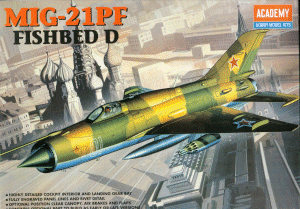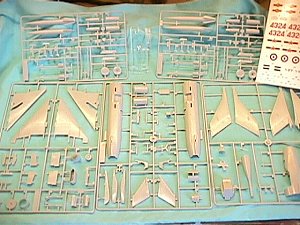

The long-awaited first installment of the Academy MiG-21 family has arrived! This also represents the first kit Academy has released since their 'divorce' from Minicraft. The first thing you'll notice is that the retail prices of Academy kits seem to have gone up since the divorce as well. The price of this first kit in the MiG-21 family has gone into Tamiya's price range. Is it worth it? Lets see:
The kit comes as five trees of light grey molded parts and a small clear tree with the clear parts as the photo depicts below. All panel lines and rivet details are nicely scribed.

The fuselage is molded in four parts - two front halves and two rear halves. The division between front and rear sections are strategically placed so that future nose sections can be substituted to perhaps give us a MiG-21F, the MiG-21MF (already on the schedule), and perhaps the two-seat Mongol variants. The dorsal spine and vertical stabilizer are molded separate from the fuselage to also facilitate the needed part swapping to create even more variants. The forward speed brakes and ventral speed brake are also separate and accurately shaped (this was a problem area on the OEZ 1/48 MiG-21).
The canopy accurately depicts the forward-hinged type of the early MiG-21s. The later MiG-21s (starting with the MiG-21PFM) had side-opening canopies with the windscreen fixed in place and the KM-1 ejection seat. The problem area here is that the real MiG-21PF had a secondary windscreen that was equipped with thick bullet-proof glass. The kit gives you sort of a representation of the glass, but not the unique framing, etc. If you have the Airfix 1/48 Buccaneer kit, the windscreen that the backseater has would be similar to what is missing in this kit. This oversight will be visible under that canopy whether it is modeled open or closed.
The cockpit tub is spartan and while the instrument panel has the radar scope properly placed for this version, the whole cockpit is begging for a resin replacement. The kit representation of the SK ejection seat has harnesses molded on, and while a nice try, they do not come close to depicting the complex shoulder harnesses on the Russian seats.
The bumps on the wings depict the version with the Fowler-flaps which were common to early MiG-21PFs and standard with all of the MiG-21F and MiG-21F-13 models (Fishbed C & E respectively). The flaps and ailerons are molded separately so there are positioning possibilities. Unfortunately, the point where the flap mounts to the wing is the later SPS type. If you want to build the Fowler flap version straight out of the box, leave the flaps up. If you want to lower the flaps, read the tips near the end of this review.
The wings are set up with four sets of flashed-over pylon mount holes. While the instructions tell you to use only the inboard holes for the MiG-21PF (correct), the outboard pylons are also included (another hint of the future).
The kit also supplies a number of items that also hint at future models. While the Fishbed C/E had two/one internal 30mm guns (respectively), the MiG-21PF and the later MiG-21PFM did not have an internal gun. They soon realized the error of their ways (as we did with the F-4 Phantom II) and added internal guns to future models. Academy provides the 23mm GP-9 gunpack that mounted on the centerline of the MiG-21PF and PFM. Nice touch! Also interesting is that the GSh-23 gun is also in the kit which was the new internal gun that started with the Fishbed J - Academy's next release.
Nobody will be able to accuse Academy of a shallow nosewheel well! It is nicely done, as is the nosecone. The main wells and doors are also nicely detailed. On the externals lineup, in addition to the guns, Academy has supplied two 16-shot 57mm rocket pods (UV-16-57) and two 32-shot pods (UV-32-57); two external tanks (on this model, you can only use one and only on the centerline (if the GP-9 gunpod isn't already in place)); 2 infrared Atoll air-to-air missiles (AAMs) and 2 radar-guided Atoll AAMS. The radar-guided missiles weren't used on the MiG-21PF, and the fins are incorrect. The infrared missiles were carried on this aircraft, but the fins are also wrong. Toss these missiles and find some old Sidewinders (AIM-9Bs to be exact). The IR Atoll is identical in appearance to the AIM-9B.
The decals and painting instructions are equally interesting. The Russian aircraft depicted on the boxart and in decal form is of a museum aircraft. The vast majority of MiG-21PFs were bare metal, as no doubt this aircraft was before it was restored for the museum. Markings are also included for a Chinese AF aircraft, though I don't believe they deployed any MiG-21PFs in their inventory. They may have acquired a few while the Soviet Union was supplying arms to Vietnam to counter the US. Markings are also provided for Egyptian and North Vietnamese Air Force aircraft.
While this was supposed to be a quick look, this was an interesting peek at a new line of MiG-21s. The only other 1/48 MiG-21PF was the Revell kit of years ago and it wasn't bad. This kit is superior, however.
This particular MiG-21, the MiG-21PF, was probably the most visually diverse of the MiG-21s produced. Within its production run, the MiG-21PF had narrow and wide chord vertical stabilizers as well as Fowler and SPS (blown) wing flaps. The kit comes with the narrow and wide chord vertical stabs, but the kit only includes the narrow chord vertical stab without the braking chute housing. The wide chord vertical stab does have the parachute housing (I don't recall a wide chord stab without the parachute housing). Ironically, the box art depicts their MiG-21PF with the narrow chord tail with the parachute housing - the combination NOT included in the kit. Don't worry, the box art is incorrect and the instructions are correct - the photo of that camouflaged museum piece confirms that particular aircraft has the wide-chord vertical stab. Look to see if the subject you want to model has the narrow chord vertical stab with the parachute housing. Surgery may be required to get that version.
As mentioned above, the wing has the flap tracks molded on for the Fowler-flap version only. Parts are included in the kit, and there is a flashed over hole just in front of the flap cut-out, for the SPS hinge assembly.
To model the SPS version, you'll have to remove the "bump" on the underside of the wing between the flap and aileron cut-outs. DON'T remove the bump on the upper wing! Keep the leading edge of the flap butted against the wing and angle it down to the desired angle.
To model the Fowler version with flaps down, cut thin sheet plastic approximately 1/4 inch wide to fill the flap cutout on the upper wing. When the Fowler flap is extended, it slides aft AND down. Position the flap about 3/16" aft of the lower edge of the flap cut-out and angle it down to the desired angle.
There is work needed here to get an accurate airplane. Because of all of the variations of the MiG-21PF, you'll definitely want pictures of your subject to you can select the right combination of tail, flaps, etc., for your topic. And while the engineering behind the kit to facilitate many versions is quite nicely done, the downside is that the fuselage has two big seams to deal with: left and right AND front and back. Not a problem if you're building a camouflaged machine. The problem is that the vast majority of MiG-21PFs were bare metal. Academy was wise not to depict this on their cover as bare metal finishes will scare off most modelers.
Is this kit worth its $25.00 asking price? I'm afraid you'll have to be the judge. I'll follow this with a build-up review and tell you more.
In the meantime, you can take a peek at a full scale MiG-21PF that was one of several MiGs here in Albuquerque a number of years ago. This particular MiG-21PF had a Fowler-flap equipped wing and a narrow chord tail without the parachute housing. Click here to see.
For outstanding information on the subject, refer to the Mikoyan MiG-21 by Bill Gunston and printed by Osprey. The museum piece depicted on the cover of this kit and on the decal sheet can be found on pages 79 and 85. Another great reference is the 4+ Publication's MiG-21. An excellent photo of the armored windscreen arrangement can be found on page 18. A nice shot of the SK ejection seat (without ANY shoulder harnesses installed) is on the next page.